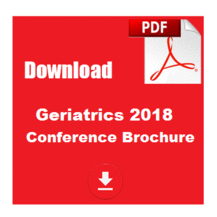
Ivana Beatrice Mânica da Cruz
Federal University of Santa Maria, Brazil
Title: Superoxide-hydrogen peroxide imbalance: Potential risk and its influence on therapeutic response of chronic morbidities prevalent in elderly people
Biography
Biography: Ivana Beatrice Mânica da Cruz
Abstract
Statement of the Problem: Aging is a complex event where mitochondrial dysfunction has been in the spotlight for a long time. Since, prior evidences suggested that mitochondrial dysfunctions are related to oxidative-inflammatory and genotoxic processes, our research team has dedicated special efforts to understand the role of a bidirectional imbalance related to superoxide anion (SA) and hydrogen peroxide (SA-HP) on aging modulation and age-associated chronic non-transmissible diseases (CNTDs).
Methodology & Theoretical Orientation: Here, we reviewed 294 studies (16 from our group) English published and PubMed-Medline indexed involving a bilateral SA-HP imbalance triggered by a human single nucleotide polymorphism (rs4880 SNP) found in superoxide dismutase manganese-dependent gene (SOD2), which produces an enzyme acting inside of mitochondria (Val16Ala-SOD2).
Findings: In biological terms, SA is constantly produced by mitochondrial respiratory chain. Therefore, SOD2 is considered first line of antioxidant enzyme that dismutates SA to HP. The SOD2-SNP is located at mitochondrial sequence target that triggers SOD2-inactive cytoplasmic protein into mitochondria. A-allele produces an alpha-helix SOD2 protein that is more efficient to into mitochondria, whereas V-allele produces a beta-sheet SOD2 protein that is partially arrested in mitochondrial membranes. 132 studies analyzed association between A-allele and several cancer types, considering that A-allele increases SA-dismutation producing an excess of HP levels. HP leaves from mitochondria to cytoplasm producing hydroxyl radical (HR) that is highly mutagenic increasing cancer-susceptibility. Main risk associated to AA-genotype is prostate cancer. V-allele presents lower SOD2-efficient and SA excess react with nitric oxide (NO) triggering lipoperoxidation. Therefore VV-genotype has been associated with different metabolic diseases, such as hypercholesterolemia, its response to rosuvastatin, and chronic inflammation.
Conclusion & Significance: SA-HP imbalance seems to have a critical role on elderly-prevalent CNTDs and could be considered an emergent geriatric focus related to prevention and control of CNTDs.

